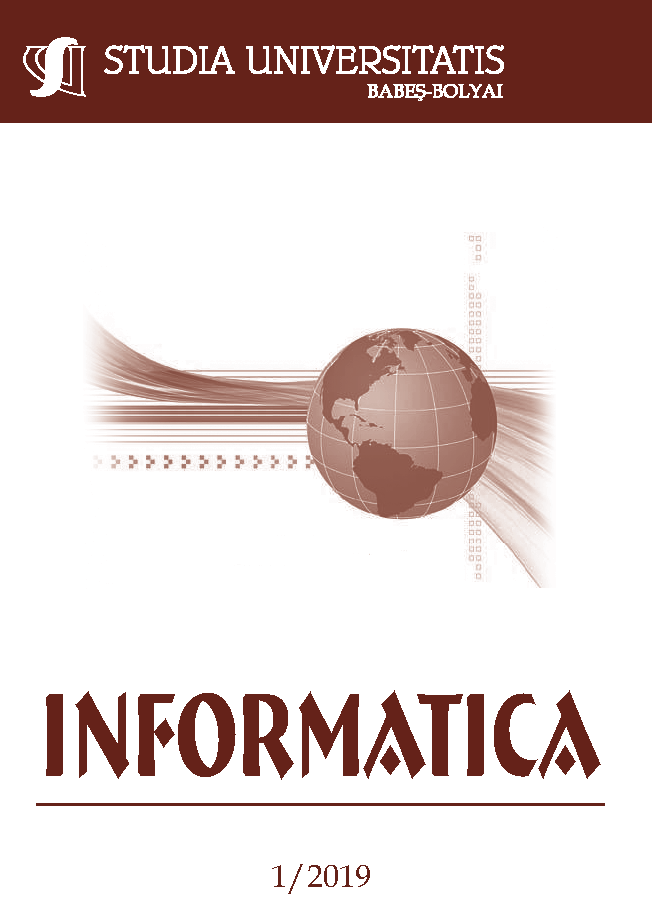AN ADDRESS PROPAGATION MODEL IN P2P AND F2F NETWORKS
DOI:
https://doi.org/10.24193/subbi.2019.1.08Keywords:
Private P2P network, F2F network, Network address discovery, symmetric and asymmetric cryptography.Abstract
Using identifiers to address the member nodes at DHT based peer-to-peer (p2p) networks provides structured method of addressing the nodes. The node lookup is then used to find the equivalent communication address of a given identifier. One of the main concerns is how to find the communication addresses efficiently, especially if a node has joined or rejoined the network recently. In this paper an address propagation model has been proposed which is used as a solution in friend-to-friend (f2f) overlays at p2p networks. The model keeps the required communication addresses up-to-date in order to reduce the need of any node to perform the lookup process. It allows each node to maintain the addresses in a distributed manner using bucket based broadcasting and guarantees that it has the current up-to-date addresses of its friend nodes as a necessary in- formation to establish a direct connection without any centralized scheme. Despite adding some traffic overhead to the network, the proposed address propagation process is secure and fast.
References
Balakrishnan, H., Kaashoek, M.F., Karger, D., Morris, R. and Stoica, I., 2003. Looking up data in p2p systems. Communications of the ACM, 46 (2), pp. 43-48.
Butler, K.R., Ryu, S., Traynor, P. and McDaniel, P.D., 2009. Leveraging identity-based cryptography for node ID assignment in structured p2p systems. IEEE Transactions on Parallel and Distributed Systems, 20(12), pp.1803-1815.
Cai, X.S. and Devroye, L., 2015. The analysis of kademlia for random IDs. Internet Mathematics, 11(6), pp.572-587.
Cohen, B., 2008. The BitTorrent protocol specification.
Czirkos, Z. and Hosszú, G., 2013. Solution for the broadcasting in the Kademlia peer-to-peer overlay. Computer Networks, 57(8), pp.1853-1862.
Isdal, T., Piatek, M., Krishnamurthy, A. and Anderson, T., 2010, August. Privacy preserving p2p data sharing with oneswarm. In ACM SIGCOMM Computer Communication Review, 40 (4) pp. 111-122.
Kamel, M., Ligeti, P. and Nagy, A., 2018. Improved Approach of Address Propagation for F2F Networks. IEEE 2018 2nd European Conference on Electrical Engineering and Computer Science (EECS).
Kasza, P., Ligeti, P. and Nagy, A., 2015. Siren: Secure data sharing over p2p and f2f networks. Studia Scientiarum Mathematicarum Hungarica, 52 (2), pp. 257-264.
Kasza, P., Ligeti, P. and Nagy, A., 2015. On a secure distributed data sharing system and its implementation. In ANNALES MATHEMATICAE ET INFORMATICAE 44, pp. 111-120.
Kohnen, M., Gerbecks, J., and Rathgeb, E.P., 2011. Applying certificate-based routing to a kademlia-based distributed hash table. Proceedings of the Third international Conference on Advances in p2p Systems IARIA, pp. 85-89.
Lua, E.K., Crowcroft, J., Pias, M., Sharma, R. and Lim, S., 2005. A survey and comparison of peer-to-peer overlay network schemes. IEEE Communications Surveys and Tutorials, 7 (2), pp.72-93.
Maymounkov, P. and Mazieres, D., 2002. Kademlia: A peer-to-peer information system based on the xor metric. In International Workshop on Peer-to-Peer Systems, pp. 53-65.
Nakamoto, S., 2008. Bitcoin: A peer-to-peer electronic cash system.
Parameswaran, M., Susarla, A., and Whinston, A.B., 2001. p2p networking: an information sharing alternative. Computer IEEE, 34 (7), pp.31-38.
Peris, A.D., Hernández, J.M. and Huedo, E., 2016. Evaluation of alternatives for the broadcast operation in Kademlia under churn. Peer-to-Peer Networking and Applications, 9 (2), pp.313-327.
Stoica, I., Morris, R., Liben-Nowell, D., Karger, D.R., Kaashoek, M.F., Dabek, F. and Balakrishnan, H., 2003. Chord: a scalable peer-to-peer lookup protocol for internet applications. IEEE/ACM Transactions on Networking (TON), 11 (1), pp.17-32.
Trifa, Z. and Khemakhem, M., 2016. A novel replication technique to attenuate churn effects. Peer-to-Peer Networking and Applications, 9 (2), pp.344-355.
Yong-Jun, G., Li-Zheng, G., and Ming-Hui, Z. 2014. Improved Multi-secret Sharing Scheme Based on One-Way Function. Indonesian Journal of Electrical Engineering and Computer Science, 12 (6), pp. 4463-4467.
Zghaibeh, M. and Hassan, N.U., 2018. d-SHAM: A Constant Degree-Scalable Homogeneous Addressing Mechanism for Structured p2p Networks. IEEE Access, 6, pp.12483-12492.
Downloads
Published
How to Cite
Issue
Section
License
Copyright (c) 2019 Studia Universitatis Babeș-Bolyai Informatica

This work is licensed under a Creative Commons Attribution-NonCommercial-NoDerivatives 4.0 International License.





